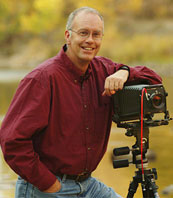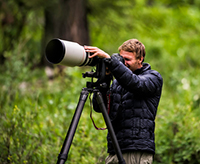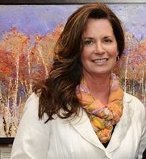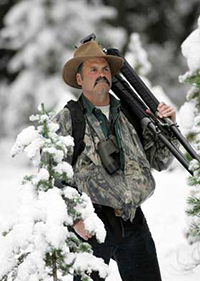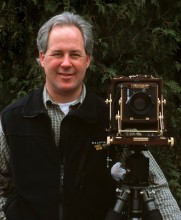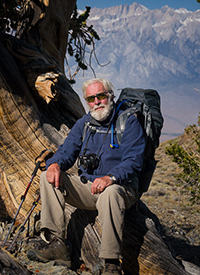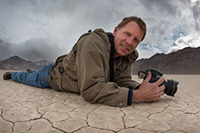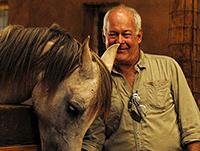David Clack has been a professional photographer for the past 23 years. He started his career as a biomedical photographer at Colorado State University. David is the CEO of Colorado Photographics, Inc., and recently opened the Illustrated Light Gallery of Fine Art Photography in Old Town Fort Collins, Colorado. In 1990, David served on the community advisory board for One West Contemporary Art Center, now the Museum of Contemporary Art (COCA). He also help co-found the Center of Fine Art Photography. David’s first book Colorado Fine Art Landscape & Nature Photography was published in 1998. He has been selling his prints in galleries throughout Colorado for many years. In 2002, David was invited to be a keynote speaker at the United Nations “Year of the Mountain” conference in Malaysia on photographing the Rocky Mountains. Having won numerous awards for his photography in both black & white and color, David’s work reflects the passion he has for photography. Most of the images displayed have been photographed with a 4×5 Toyo large-format field camera. The two types of film that Dave uses most are Fuji Velvia (ASA 50) and Provia (ASA 100). The images are then printed as an archival giclée print using the state of the art technology. Because of the large format camera and the type of printing process used, Dave can enlarge an image to mural size without losing sharpness and still maintain the vivid colors and detail found in the original transparency. With the giclée process, Dave can print on a variety of substrates. Displayed under UV glass a giclée, can last up to 150 years.
“As a young boy, I would hike and camp throughout the Colorado wilderness. I marveled at the beauty and purity of it all: the crisp, clean air and the sound of wind rustling through the tops of ponderosa pine. Growing older I wondered: “Where did all this come from, how could something so beautiful exist?” In the back of my mind I knew it was God’s creation, yet I suppressed those thoughts, not wanting to deal with the confrontation of God’s existence and mine. Now as an adult, I have reconciled my separation from God through Jesus Christ, my Lord and Savior, through whom all things are possible. So, it is my joy and honor to thank Him who has made the culmination of these images possible for you to enjoy.”
“You are worthy, our Lord & God, to receive glory and honor and power, for You created all things . . .” Rev. 4:11
“For since the creation of the world God’s invisible qualities–his eternal power and divine nature–have been clearly seen, being understood from what has been made, so that men are without excuse.
for His blessing and letting me live out Ecclesiastes 3:22.
Former Professor of Botany, Willard Clay has been a full-time photographer since 1982. Specializing in large format photography, Willard Clay has been the primary photographer for nine coffee table books and has been published in a myriad of calendars, magazines, books, and advertising agencies. Portfolio consists of large format film and high-resolution digital files ready for publication.
From growing up on Cape Cod, to raising my own family in Colorado, my life has continually been filled with movement and color–the most essential elements of my work. While these elements have always been present, my self-awareness as an artist did not surface until much later in life. I grew up, one of six children, in a little town called Falmouth, Massachusetts. It was during high school that I first discovered my appreciation for art, and that I had a knack for it. Not knowing what to do with this knack, and needing a change of environment, I joined the Air Force after graduation. During my service, I was fortunate enough to travel all over this country, as well as others, and to see the world through a different lens. During my final years in the reserves, I began focusing more on art and earned a degree in Interior Design. After working with an architect for a short time, I found that this type of work did not allow me the creative expression for which I was searching, so I began painting for myself again. I had finally found a medium and a method that was satisfying and I wanted to learn more. I taught myself, through trial and error, to capture the curve of a calla lily, the rolling shadows of a mountain and the ever-changing colors of a forest. My artistic influences include the works of Wolf Kahn and Georgia O’Keefe, among others. I have worked with media ranging from copper, pastels and textured paper to acrylic paint and varyingly textured canvas. My tools have ranged from my own fingers, paintbrushes, and socks to my more recent favorite, a palette knife. My work is an expression of movement and color, as well as a transmission of emotion. Art has always been my chosen form of expression, and all that I hope to evoke from my viewers is exactly what I derive from the work myself: feeling, spirit and passion.
Clients world wide have appreciated and purchased Howard’s photographic work for usage rights and office or home décor. Hospitals display his work to ease tension and raise the spirits of patients in a place that could otherwise appear cold or foreboding. Businesses use his beautiful images of the natural world to create a more calming, cooperative and productive environment. Individuals love the soothing atmosphere created in a home with Howard’s fine art nature photography on the walls. His background, talent, passion and willingness to explore rarely visited wild places of the American west all combine in the creation of his insightful and meaningful images. Howard is completely self taught and is now sought after to teach. Reproductions of his work number in the millions and countless lives have been improved from the positive influence of his work.
Howard’s many credits include diverse publications and companies such as The National Geographic Society, Warner Bros. MGM, Hallmark, AT&T, Sierra Press, Browntrout, Audubon, Healthy Planet, PhotoGraphic, Beautiful America Publications, Angel Graphics, Portal Publications, Outside, Blue Sky Publishing, Reiman Publications, Smith Western, Sierra Club, Great Mountain West, Western Image, Westcliffe Publishers, Northwest Publications and hundreds more.
To navigate Leland Howard’s photographic art in themed gallery format for wall decor, prints and wall art please visit www.LelandHoward.com.
Washington State photographer, James T. Jones, has earned his living for the past 24 years on the edge of unfolding wildlife adventures, photographing the spectacular, dramatic, and surprising events of his travels.
A dedicated family man, Jim loves to share his desire to explore, experience and photograph nature with his wife, Janet, son Jack, and daughter Jennifer. they have experienced many memorable moments together on some of Jim’s expeditions to Alaska, British Columbia, Manitoba, all of the northwest United States, the Southwest, and Africa.
Jim’s award-winning photographs, known for their incredible sharp detail and accurate colors, are proudly displayed in galleries and private collections throughout America and many countries around the world. Jim’s unique images have also appeared in, and on the front covers of, corporate publications, commercial brochures, outdoor equipment catalogues, travel and outdoor magazines, note cards, calendars, and books.
Jim and his wife Janet work together and strive to bring you a top quality, ready to enjoy, wildlife print that you can be proud to own or give as a gift. These beautifully crafted prints are printed on high quality paper with 200-year old archival inks, then hand-signed by James. Janet adds the woman’s perspective as she studies each photograph carefully for its overall color scheme and then hand-cuts the appropriate colored mats that will enhance the image, thus complementing the decor of any house or office. Enjoy these special moments of nature’s majestic beauty.
Joseph Kayne photographs the American landscape, the Heartland, and Native American archaeological sites with a 4×5 large format view camera. His latest project, entitled “Chicagoesque,” portrays a unique view of his native Chicago. Joe’s photographs have been exhibited in galleries, museums, and private collections across the country. His clients include The Nature Conservancy, Sierra Club, National Audubon Society, CF Martin Guitar Co., and the U.S. Department of Energy. Joe has a rare collection of large format images of the tallgrass prairies and American barns. He was one of the first color photographers to portray the Anasazi archeological sites and dwellings as an art form, and he is well known for his barn images and large format nature photography.
Joe’s interest in photography started while he was working in archaeology in Egypt and Israel during his college years. He received an art grant from the City of Chicago and has been a featured lecturer at the View Camera Magazine Large Format Photography Conference. Joe’s publication credits include: Lenswork, View Camera magazine, Coldwater Creek, Sierra Club, Arizona Highways, Audubon Calendars (cover), Nature Conservancy (cover), Photo Life magazine, Natural History magazine, and the Chicago Tribune. Joe was a featured photographer and named a “Lord of the Landscape” in Outdoor Photographer magazine’s landscape collector’s issue and is recognized as a long time large format nature photographer.
Joe is currently showing work at the 4Art Gallery in the Zhou B. Art Center in Chicago. Three of Joe’s photographs were included in EGO, a photo exhibition with a focus on the exploitation, glorification and objectification of the individual, in the main gallery at the Zhou B Art Center, Chicago (August-September 2013).
David Muench has photographed the landscape in all its grandeur for half a century. Traveling the U.S. since early childhood with his father, renown photographer Josef Muench, there was never another way of life for him. His 4 x 5 large format camera is as much a part of him as his innovative eye. He has lately been experimenting with digital cameras as a result of his work photographing World Heritage Sites for UNESCO and Panasonic. For him, every photograph is a journey in perception, an exploration in seeing.
Inventor of original and oft-imitated approaches to the landscape, Muench brings his own idea of geography into both his spectacular color and black and white images. For him, the craft and the art of photography are paramount, yet nothing is more important than presenting his beloved wilderness to viewers so that they might be moved to act on its behalf. For him, all of nature is a context, each tiny element of critical importance to the magnificence of the whole. It is this connectedness he seeks, an idea he presents in the book, Plateau Light.
“When photographing, I tune in to the natural rhythms and pulse of the land . . . to communicate and champion the stark beauty that is nature – its wildness, its opposites . . .” As James Lawrence wrote in the text for Plateau Light, “Muench’s international reputation derives from an unflinching embrace of nature’s nuances. He engages the primal landscape across all the human fronts: as thinker, dreamer, seeker, lover, lifelong friend.”
Long intimate with America’s wild places, in recent years Muench has expanded outward across the globe, photographing in Antarctica, New Zealand, Australia, Iceland, Japan, Morocco, South Africa, the Galapagos, Patagonia, Russia, Belarus. “I am inspired by the power and beauty of the primal landscape,” Muench says. “In the unending experience it offers of light, space and time, I engage in my equally unending search for sublime beauty.”
Muench’s work has been exhibited in numerous museums and galleries, including the Santa Barbara Museum of Art, and Mountain Light Gallery in Bishop, California. A shared exhibit with Ansel Adams and Jack Dykinga was mounted at the Phoenix Art Museum, The Center for Creative Photography, and the Museum of Northern Arizona. He was commissioned by the National Park Service to provide 33 photographic murals presenting the landscapes of the Lewis and Clark expedition. These are on permanent display at the Jefferson Expansion Memorial under the Arch in St. Louis. Monumental in concept, the 15 foot tall panels extend more than 350 feet along their wall. His work also hangs in numerous private collections. He has published over 50 exhibit format books.
Marc Muench has been a professional landscape and sports photographer for over 20 years. After completing his studies at Pasadena Art Center College of Design in the spring of 1989, Marc immediately began photographing for book publishers such as Graphic Arts Center, Browntrout Publishing and Time Inc. Soon after, Marc represented Canon Camera in several ad campaigns, as well as appearing on “Canon Photo Safari” which aired on ESPN outdoor block, for eight straight seasons.
Marc has worked with such companies as Leo Burnett, IMI, Kodak, Grey Advertising, Ogilvy and Mather, McCann Erickson, Karsh and Hagan, Hakuhodo Inc., Hallmark, Time-Life, Reader’s Digest and The National Geographic on various projects.
Marc was designated by Kodak in 2003 as a Kodak Photo Icon. Marc’s photography has appeared on covers or inside Time, National Geographic, Traveler, Arizona Highways, Ski, Skiing, Sunset, Outside, Sierra Magazine, etc. His work also appears in books, calendars, note cards, postcards, posters and annual reports.
Marc is now the “artist in residence” at dgrin.com for Smugmug, where he contributes on a regular basis to the “Muench University” critique thread. He is currently the photo editor of the National Parks guide, published by The American Park Network, which contain many of his images taken throughout the United States National Park system.
Marc recently completed a year long video project on Catalina Island for the Catalina Island Conservancy. The five minute video highlights the new Trans Catalina Trail, capturing dynamic landscapes, wildlife and of course the hikers exploring their way across the Island.
Capturing powerful experiences in a still image carries many difficulties. Combining my experience with the drama of nature and the art of creating images keeps me motivated. With no control over weather, light or geography a photographer must study the subject/landscape and place himself in the most unique position as to arrange all the variables in what will become an interesting composition. There are those serendipitous moments when all the elements of a great image fall into place. When I am surrounded with scenarios of light, subject, location, weather and timing, I compose images that remind me what is possible if I’m diligent about perusing them. I am a very blessed person to have experienced so much of life thus far, through the pursuit of photography.
Marc was born on October 14, 1966 in Santa Barbara, California, where he now resides with his wife, Stefanie and their three children.
After successfully spending over 20 years as a high-end advertising photographer in San Francisco, I found myself disenchanted, burned out, and ultimately receiving no nourishment from the work I was doing. On the outside, I had everything anyone would want, but my inner landscape was barren and I began “searching” for my lost spirit.
When horses came into my life in the mid-1990’s, I realized that I had found my teachers, and the connection that I have developed with horses has helped steer my life in a completely different direction. Horses have taught me so much in the time that I have spent with them. They have taught me about the power of authenticity, honestly, and integrity, and they have taught me the true meaning of leadership and relationship. They have also taught me about living in collaboration and community, rather than the model that our society embodies, which is about competition and “getting ahead of the rest”.
I feel my work is an homage to the equine spirit, and to the archetypal role they play in our lives. This is why I always photograph them without riders, saddles, bits, bridles or any other device that would interfere with their pure essence.
After publishing my first 2 books “Spirit Horses” and “The Forgotten Horses”, I have worked on a new book, Horse Medicine that just got published, which is my latest collection of photography, and also includes text about the role horses play for us as teachers and healers, and the profound lessons they provide for us… if we are willing to listen.

